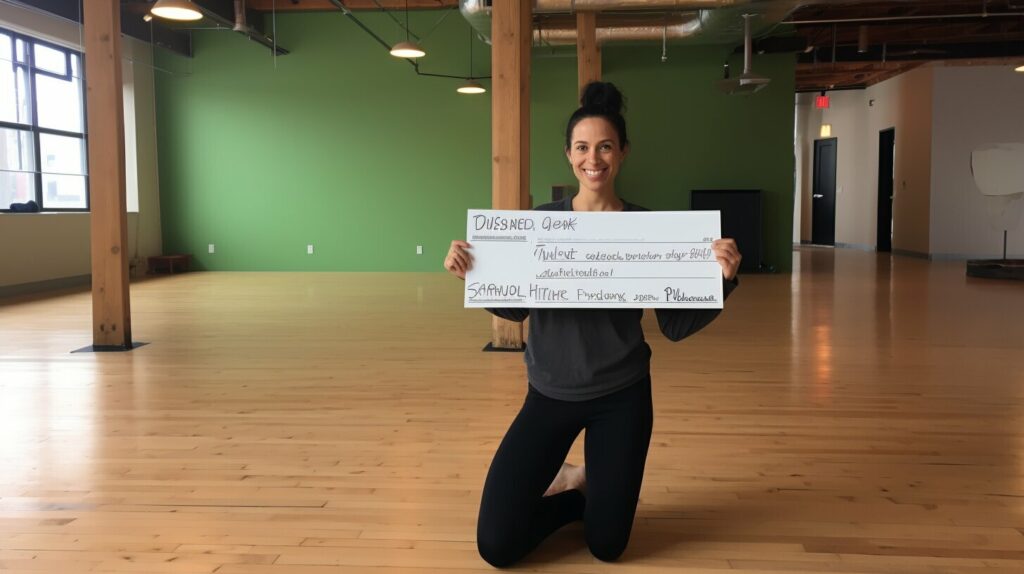Yoga is an ancient practice that has gained immense popularity across the world in recent times. In the UK, yoga has become a part of many people’s daily routines, and this has created numerous opportunities for yoga teachers. However, many aspiring yoga teachers are often uncertain about how they will get paid for their services.
The payment methods and salary dynamics of yoga teachers in the UK can be quite different from other industries. Some yoga teachers charge hourly rates, while others offer class packages or subscription models. Additionally, market demand and competition can significantly impact the earning potential of yoga instructors.
In this article, we will explore how yoga teachers get paid in the UK. We will delve into the various payment options available to yoga teachers and the factors that can influence their earning potential. Understanding the income dynamics of the profession is essential for both aspiring and existing yoga teachers.
- Yoga teachers in the UK can earn money through various payment options, including hourly rates, class packages, and subscription models.
- The average hourly rate of yoga instructors in the UK can vary based on location, experience, and specialization.
- Yoga teachers in the UK can also earn additional income through workshops, retreats, online classes, and corporate sessions.
- Understanding tax obligations and implementing effective marketing strategies is crucial for maximizing the earning potential of yoga teachers in the UK.
- Proper financial planning is essential for long-term success in the profession.
Payment Options for Yoga Teachers in the UK
Yoga teachers in the UK can receive payment through various methods. Some of the most common options for yoga teacher compensation in the UK are hourly rates, class packages, and subscription models.
Hourly rates are the most straightforward payment option, with teachers charging a set rate for each hour of instruction. Factors such as location, experience, and specialization can affect the hourly rate that a yoga teacher can charge. It is essential for teachers to research the average hourly rate in their area to ensure they are charging a competitive price.
Class packages provide students with the ability to purchase a set number of classes at a discounted rate. This payment option offers students flexibility while also guaranteeing a steady stream of income for the yoga teacher. Subscription models work similarly to class packages, except students pay a monthly fee for unlimited classes. These options can be beneficial for yoga teachers looking to establish a consistent client base.
Another payment option for yoga teachers is to offer private sessions, which can often result in a higher hourly rate. Additionally, yoga teachers can diversify their income by offering workshops, retreats, and online classes.
It is crucial for yoga teachers to explore their payment options and determine which method works best for their business. Offering multiple payment options can be beneficial to attract a wider range of students and ensure steady income.

Yoga teaching income in the UK varies depending on several factors, including experience, location, and the type of yoga instruction. On average, yoga instructors in the UK earn between £20 and £40 per hour. However, rates can be higher for those with significant experience or specialized skills. For example, instructors who specialize in prenatal or therapeutic yoga may command higher wages.
Location can also significantly impact hourly rates, with yoga teachers in London, for instance, earning higher rates than their counterparts in other regions. Similarly, instructors who teach at high-end studios or private clients can also command higher wages.
It is worth noting that hourly rates do not always reflect the total earnings of yoga instructors in the UK, as income can also come from class packages, subscription models, and additional income streams, as discussed in the preceding sections.
Class Packages and Subscription Models
Aside from hourly rates, yoga teachers in the UK can offer class packages and subscription models as payment options. These methods provide students with flexibility and affordability while offering instructors consistent revenue streams.
A class package typically consists of a set number of classes that students can attend over a specified period, such as a month. Yoga teachers can set the price for the package, which can be cheaper per class compared to paying for classes individually. This option allows students to plan their budgets effectively and commit to attending classes regularly.

Subscription models, on the other hand, allow students to access unlimited classes for a fixed monthly fee. This model encourages student loyalty and helps yoga teachers generate stable monthly income. However, ensuring that the price of the subscription is affordable for students while also allowing for adequate income for the instructor can be a challenge, and careful consideration must be given to pricing and value.
Both class packages and subscription models require upfront investment from students, so marketing them effectively is crucial. Yoga teachers can promote packages and subscriptions on their websites and social media platforms, highlighting the benefits of committing to a set number of classes or unlimited access.
However, not all students will be interested in these payment options, and providing hourly rates as an alternative remains essential. Understanding the diverse payment preferences of students can create opportunities for yoga teachers to increase their earning potential.
Additional Income Streams for Yoga Teachers in the UK
Yoga teaching can be a rewarding career, not just emotionally but also financially. As we discussed earlier, yoga teachers can earn a good income through their hourly rates, class packages, and subscription models. But in addition to these, there are also other opportunities to increase earning potential and diversify income streams.
One such opportunity is to offer workshops and retreats. These can be single-day or multi-day events that focus on a specific aspect of yoga, such as mindfulness or meditation. Workshops and retreats allow yoga teachers to share their expertise and offer a deeper, more immersive experience for their students. They can be held locally or internationally, depending on the teacher’s preferences and expertise.
Another way to increase income is to offer online classes. With the rise of technology and the internet, online yoga classes have become increasingly popular. These can be live-streamed classes or pre-recorded sessions that students can access at their convenience. Not only do online classes offer convenience for students, but they also provide an opportunity for yoga teachers to reach a wider audience and increase their income.

Corporate sessions are another potential income stream for yoga teachers in the UK. Many companies now offer wellness programs for their employees, which often include yoga classes. Yoga instructors can offer these services as part of a corporate wellness package, providing an excellent opportunity to promote their expertise and earn additional income.
Finally, yoga teachers can also consider writing a book or creating an online course to share their expertise and offer valuable insights to a wider audience. While writing a book or creating an online course can be time-consuming, it can also provide passive income in the long term and enhance the teacher’s reputation in the industry.
Exploring these additional income streams can help yoga teachers in the UK earn more and diversify their income sources. By expanding their offerings and reaching a wider audience, they can create a more sustainable and fulfilling career as a yoga instructor.
Yoga Teacher Salary in the UK
In the United Kingdom, the average salary for a yoga teacher ranges from £15,000 to £45,000 per year. The salary can vary depending on a number of factors, including qualifications, experience, and the type of yoga instruction being offered.
It’s important to note that yoga teaching is not always a full-time job, and many instructors work part-time or have additional income streams to supplement their earnings. However, for those who are committed to the profession, there is potential to earn a decent salary and make a comfortable living as a yoga teacher in the UK.
If you’re wondering how to make money as a yoga teacher in the UK, it’s essential to consider the factors that can influence your salary and take steps to maximize your earning potential. This may involve continuing your education and obtaining advanced certifications, specializing in a specific type of yoga, or exploring additional income streams such as workshops or corporate sessions.
| Qualifications | Average Salary |
|---|---|
| 200-hour Yoga Teacher Training (YTT) | £15,000 – £25,000 |
| 500-hour YTT or Advanced Certification | £25,000 – £45,000 |

Another factor that can impact yoga teacher salary is location. While salaries may be higher in larger cities such as London, living expenses may also be higher. It’s important to consider the cost of living when evaluating salary potential in different areas of the UK.
Overall, it’s important for yoga teachers to be realistic about their earning potential and take steps to manage their finances effectively. This may involve budgeting, saving, and planning for retirement as a yoga instructor. By understanding the salary dynamics of yoga teaching in the UK and taking a strategic approach to their careers, yoga teachers can create a successful and rewarding profession.
Self-Employment vs. Employment as a Yoga Teacher in the UK
When it comes to working as a yoga teacher in the UK, there are two main options: self-employment and employment. Each has its own set of pros and cons, and it’s important to consider them carefully before making a decision.
Self-Employment:
Many yoga teachers in the UK choose to work for themselves. This gives them the freedom to set their own schedule, rates, and teaching style. They also have complete control over their business and can make all decisions regarding their classes, marketing, and finances.
However, self-employment also comes with its own challenges. Yoga teachers must be prepared to handle all aspects of running a business, including marketing, accounting, and customer service. They must also provide their own equipment and find their own clients. Additionally, they are responsible for paying their own taxes and ensuring they have the appropriate insurance coverage.
Employment:
Another option for yoga teachers in the UK is to work for a yoga studio, gym, or other fitness facility. This provides a steady income and the opportunity to work with a team of other instructors. It also takes the burden of business management off the yoga teacher, allowing them to focus solely on teaching.
However, employment also comes with its own challenges. Yoga teachers may have less flexibility in terms of their schedule and teaching style. They may also have less control over their rates and the classes they teach. Additionally, they may be limited in their earning potential and may not receive benefits such as healthcare or paid time off.
| Self-Employment | Employment |
|---|---|
| Freedom to set own schedule, rates, and teaching style | Steady income and opportunity to work with a team |
| Complete control over business | Less flexibility in schedule and teaching style |
| Responsibility for all aspects of business management | Less control over rates and classes taught |
| Potentially higher earning potential | Limited earning potential and benefits |
Ultimately, the decision between self-employment and employment as a yoga teacher will depend on individual goals and preferences. Some may thrive with the independence and control of self-employment, while others may prefer the stability and support of working for someone else.
Whichever option is chosen, it’s important for yoga teachers in the UK to consider their compensation carefully. By understanding the earning potential and tax implications of each option, they can make informed decisions and build successful careers in the yoga industry.

Market demand and earning potential are two critical factors that impact the success of yoga teachers in the United Kingdom. The demand for yoga classes can vary depending on various factors, including location, competition, and trends. As such, it’s essential for yoga teachers to understand the market dynamics and adjust their services accordingly to maximize their earning potential.
The income potential for yoga teachers in the UK can also vary significantly based on qualifications, experience, and the type of yoga instruction being offered. On average, yoga instructors in the UK earn between £20 and £40 per hour, depending on their level of experience and specialization.
However, it’s important to note that income potential is not only limited to hourly rates. Yoga teachers can also diversify their income through additional streams, including workshops, retreats, online classes, and corporate sessions. These opportunities can significantly increase their earnings and provide financial stability.
As the demand for yoga continues to rise in the UK, there is a growing need for qualified and experienced yoga teachers. By understanding the market demand and their earning potential, yoga instructors can develop effective strategies to attract clients and grow their business.

Overall, the market demand and earning potential for yoga teachers in the UK offer opportunities for growth and long-term success in the profession. By staying informed and adaptable, yoga instructors can maximize their income and create a thriving career in the evolving yoga industry.
Financial Planning for Yoga Teachers in the UK
As a yoga teacher in the UK, it is essential to have a solid financial plan in place. With proper budgeting and saving, you can ensure your long-term success in the profession.
One of the best ways to manage your finances is to create a budget. Start by tracking your income and expenses, and then set financial goals for yourself. By tracking your spending, you can identify areas where you can cut back and save money.
Another important aspect of financial planning is saving for the future. As a self-employed yoga teacher, you will not have access to a traditional pension plan. Therefore, it is crucial to start saving for retirement as early as possible.
There are several options for retirement savings, such as personal pensions and Individual Savings Accounts (ISAs). It is recommended that you speak with a financial advisor to determine which retirement savings option is best for you.
As a yoga teacher, you will also need to consider your tax obligations. You will be responsible for filing your taxes and paying both income tax and National Insurance contributions. It is important to keep accurate records of your income and expenses to ensure that you pay the correct amount of taxes.
Finally, consider seeking the advice of a financial planner who specializes in working with self-employed individuals. They can offer guidance on budgeting, tax planning, and retirement savings to ensure your financial success as a yoga teacher in the UK.

When it comes to payment methods and compensation, yoga teachers in the UK are considered self-employed individuals responsible for managing their finances and tax obligations. Therefore, it is important to understand the tax considerations that come with being a yoga teacher in the UK.
Firstly, yoga teachers need to keep proper records of their income and expenses to ensure they can complete their self-assessment tax returns accurately. This includes keeping track of all their income streams, such as class fees, workshop fees, and any other additional income streams.
Yoga teachers also need to be aware of their tax obligations, including National Insurance contributions and income tax. The tax rate for self-employed individuals in the UK varies based on their earnings. It is essential to stay up to date with the latest tax laws and regulations to ensure accurate tax returns.
Additionally, yoga teachers may be eligible for certain tax deductions and allowances. For example, if they work from home, they may be able to claim a portion of their home expenses as business expenses. It is important to seek advice from a qualified accountant to ensure all available deductions are identified and claimed.
Overall, understanding the tax implications of being a yoga teacher in the UK is essential for effective financial management. Ensuring accurate tax returns are completed, staying up to date with tax laws and regulations, and seeking advice from a qualified accountant are crucial steps to take to avoid any potential financial penalties.

One of the most critical aspects of making money as a yoga teacher in the UK is effective marketing and promotion. With so much competition in the industry, it’s essential to stand out and attract clients to your services.
One way to market your yoga services is by using social media platforms such as Instagram and Facebook. Create an account for your yoga practice and post updates, photos, and videos regularly. Use relevant hashtags to attract followers and engage with your audience by responding to comments and messages promptly.
Another way to promote your yoga services is to offer special discounts or promotions to new clients. For example, you could offer a free introductory class or a discount on a class package to encourage new students to try your classes.
Building partnerships with local businesses can also be an effective marketing strategy. Reach out to gyms, health food stores, and wellness centers in your area and offer to teach a free class or workshop. This will allow you to showcase your skills and attract potential clients.
Finally, consider creating a website for your yoga practice. A website can be an excellent tool for showcasing your services, sharing your class schedule, and allowing prospective clients to book sessions online. Be sure to include testimonials from satisfied clients to build credibility and trust with visitors to your site.

By implementing these marketing strategies, you can attract more clients to your yoga practice and increase your earning potential in the UK. Remember to stay consistent with your marketing efforts and always strive to provide high-quality services to your clients.
Conclusion
In conclusion, understanding how yoga teachers get paid in the UK is essential for anyone considering the profession. There are various payment options and salary dynamics to be aware of, and it’s crucial to carefully manage finances, consider tax obligations and implement effective marketing strategies.
By exploring additional income streams and diversifying their yoga instruction, teachers can increase their earning potential. This can include offering workshops, retreats, online classes and corporate sessions.
It’s also important to consider the pros and cons of self-employment versus employment as a yoga teacher, taking into account financial implications and the level of control and flexibility associated with each option.
Understanding the market demand and earning potential for yoga teachers in the UK is crucial for maximizing income. By carefully managing finances, considering tax obligations and implementing effective marketing strategies, yoga teachers can create a successful career in the United Kingdom.
Financial planning and tax considerations
Proper financial planning is essential for long-term success as a yoga instructor in the UK. This includes budgeting, saving and planning for retirement. It’s also important to consider tax obligations, deductions and allowances specific to the profession.
Marketing and promoting yoga services
Effective marketing is crucial for attracting clients and increasing income as a yoga teacher in the UK. This can include utilizing various strategies and platforms such as social media, word-of-mouth, and partnerships with other businesses.
In summary, by understanding payment options, salary dynamics, additional income streams, and market demand, yoga teachers can maximize their earning potential and succeed in the profession.
FAQ
Q: How do yoga teachers in the UK get paid?
A: Yoga teachers in the UK can receive payment in various ways, including hourly rates, class packages, subscription models, and additional income streams such as workshops and retreats.
Q: What are the payment options for yoga teachers in the UK?
A: Yoga teachers in the UK have the flexibility to choose from different payment options, including hourly rates, class packages, and subscription models. They can also explore additional income streams such as corporate sessions and online classes to diversify their earnings.
Q: What are the average hourly rates for yoga instructors in the UK?
A: The average hourly rates for yoga instructors in the UK can vary depending on factors such as location, experience, and specialization. It is best to research the local market to understand the going rates in your area.
Q: How do class packages and subscription models work for yoga teachers?
A: Class packages and subscription models allow yoga teachers to offer their students the option to purchase multiple classes or subscribe for a set period. This can provide a steady income stream and encourage students to commit to regular practice.
Q: What are the additional income streams available to yoga teachers in the UK?
A: Yoga teachers in the UK can explore various additional income streams, including conducting workshops and retreats, offering online classes, providing corporate sessions, and collaborating with wellness brands or organizations.
Q: What is the average salary range for yoga teachers in the UK?
A: The average salary range for yoga teachers in the UK can vary depending on factors such as qualifications, experience, and the type of yoga instruction being offered. It is best to research the local market and consider these factors when determining your salary expectations.
Q: What are the pros and cons of being self-employed versus being employed as a yoga teacher in the UK?
A: Being self-employed as a yoga teacher provides more control and flexibility over your schedule and business decisions but also comes with the responsibility of managing your finances and tax obligations. Being employed as a yoga teacher may provide more stability but can limit your flexibility and control over your teaching practice.
Q: What is the market demand and earning potential for yoga teachers in the UK?
A: The market demand for yoga classes in the UK can vary depending on factors such as location, competition, and trends. Understanding the local market dynamics can help yoga teachers maximize their earning potential by identifying market gaps and catering to specific clientele.
Q: How should yoga teachers in the UK plan their finances?
A: Proper financial planning for yoga teachers in the UK includes budgeting, saving, and planning for retirement. It is important to manage your income wisely, set aside funds for taxes, and create a long-term financial plan that supports your career as a yoga teacher.
Q: What tax considerations should yoga teachers in the UK be aware of?
A: Yoga teachers in the UK should be aware of their tax obligations, deductions, and allowances specific to their profession. It is advisable to consult with a tax professional or seek guidance from HM Revenue and Customs (HMRC) to ensure compliance and maximize tax benefits.
Q: How can yoga teachers market and promote their services in the UK?
A: Marketing and promoting yoga services in the UK can be done through various strategies and platforms, such as social media marketing, creating a website or blog, partnering with local businesses, offering introductory classes or special promotions, and networking within the wellness community.
